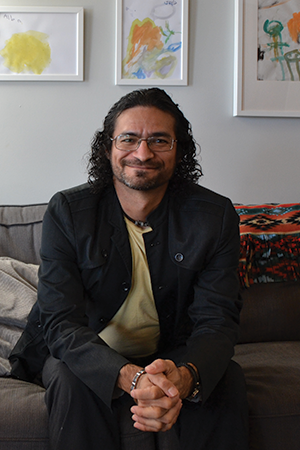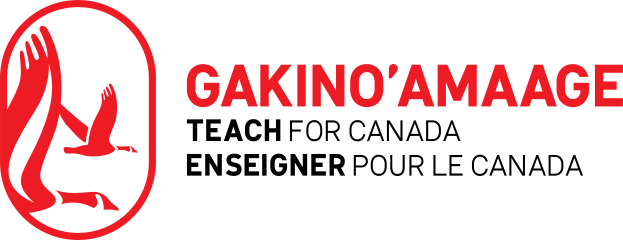Our Name
In March 2023, Teach For Canada received the Anishinaabemowin name Gakino’amaage.
Teach For Canada recognizes the historical and ongoing impacts of colonialism on Indigenous peoples in Canada and understands education’s role in perpetuating these injustices.
The organization, under Executive Director, Ken Sanderson’s leadership, has been on an organization-wide decolonization journey. As part of this journey, Teach For Canada sought a traditional name obtained through ceremony.
Gakino'amaage
Anishinaabemowin for “one who teaches”
You might ask yourself, what does this change mean for Teach For Canada? We are still the same team, working towards our mission to support student success by recruiting and developing committed educators in partnership with First Nations, teachers and supporters.
Going forward, you will hear us refer to our organization less as Teach For Canada and more as Gakino’amaage. We hope to become increasingly identified by our Anishinaabemowin name, and we understand that this process takes time.
“The name that we were given through ceremony–Gakino’amaage–translates to ‘one who teaches,’ but it goes beyond literal translation. It speaks to the fact that we’re all teachers, life-long learners, and students. It encompasses the reciprocal nature of teaching. In some way or another, we are all teachers, from the smallest child to the oldest Elder.”

Read an article about the journey—led by Executive Director Ken Sanderson—that brought Teach For Canada to receive its traditional name.
Gakino'amaage FAQ
When our organization was established in 2015, the name Teach For Canada was chosen. In its early days, conversations between Teach For Canada and First Nations Community Partners established a shared goal of First Nations education equity. Our organization required a distinct model and approach to address the twin challenges of teacher supply and turnover, compounding historical injustice and systemic inequities that produce a statistical education gap between First Nations and non-First Nations students.
Teach For Canada was established under the guidance of First Nations community members and a Circle of Advisors that included Indigenous professionals from various fields. The Circle of Advisors played a critical role in the foundation of Teach For Canada. Together, they brought national experience in rural, remote, and Indigenous education, having served as teachers, principals, superintendents, education directors, professors, and in other leadership positions nationwide.
The Advisory Council, made up of representatives from First Nations Community Partners, played a critical role in ensuring that Teach For Canada was established as culturally responsive, accountable, and effective in addressing educational inequality in First Nations communities. Today, the Council’s input and guidance continue to ensure that Teach For Canada’s approach to partnerships and programming remains respectful, collaborative, and impactful.
Teach For Canada recognizes the historical and ongoing impacts of colonialism on Indigenous peoples in Canada and understands education’s role in perpetuating these injustices. The organization, under Executive Director, Ken Sanderson’s leadership, has been on an organization-wide decolonization journey. As part of this journey, Teach For Canada sought a traditional name obtained through ceremony.
Gakino’amaage is Anishinaabemowin for “one who teaches”. The meaning behind the name extends beyond literal translation. It speaks to the fact that we are all teachers and that both teaching and learning are lifelong processes. It encompasses the reciprocal nature of teaching and learning and how teachers learn as much from their students as their students learn from them.
/ˈɡɛˈki ˈNˈoʊə ˈMɑ ˈkeɪ/
Click below to hear audio of the pronunciation.
Teach For Canada recognizes the historical and ongoing impacts of colonialism on Indigenous peoples in Canada and understands education’s role in perpetuating these injustices. The organization, under Executive Director, Ken Sanderson’s leadership, has been on an organization-wide decolonization journey. As part of this journey, Teach For Canada sought a traditional name obtained through ceremony.
Executive Director Ken Sanderson was introduced to Elder Wally Swain of Keeseekoowenin Ojibway Nation (Treaty 2). Ken approached Elder Swain with tobacco to request a traditional name for Teach For Canada.
Elder Swain conducted a naming ceremony and received the name Gakino’amaage, which he then passed on to our organization.
The name Gakino’amaage was given to Teach For Canada through a ceremony led by Elder Wally Swain of Keeseekoowenin Ojibway Nation (Treaty 2). Elder Swain is part of a group of Elders and Traditional Knowledge Keepers working to protect and share traditional knowledge and teachings.
In December 2022, Executive Director Ken Sanderson approached Elder Wally Swain of Keeseekoowenin Ojibway Nation (Treaty 2) with tobacco to request a traditional name through ceremony.
Teach For Canada received the name Gakino’amaage in January 2023, before transitioning to adopt it in March 2023. In February 2024, the organization updated the spelling of their traditional name to align with a more widely recognized format used in language teaching and resources.
Yes. In February 2024, Teach For Canada updated the spelling of our traditional Anishinaabemowin name to align with a more widely recognized format used in language teaching and resources. It’s essential to note that Anishinaabemowin, like many Indigenous languages, has predominantly been spoken rather than written. Transcribing these oral languages into colonial written forms presents inherent challenges.
Although there isn’t unanimous agreement on the exact spelling of various words and phrases, the current spelling attempts to phonetically capture the oral expression as closely as possible. Different language experts, teachers, or sources may provide variations in spellings, such as gakinaamaage, gekinoo’amaaged, giki’noo’amaage, or gaakikinoo’amaget.
Gakino’amaage is an Ojibway word in the Anishinaabemowin language.
The name that we received is in Anishinaabemowin because the Elder who conducted the naming ceremony is Anishinaabe.
This choice does not suggest that one language is superior to another. Gakino’amaage: Teach For Canada works with First Nations who use a number of languages and dialects, including Ojibway, Cree, Oji-Cree, Dene, and Anishinaabemowin. While our path led us to this name through ceremony, we continue to work with and honour all Indigenous language groups.
Yes. While we hope to become increasingly identified by our Anishinaabemowin name, we understand that this process takes time. Going forward, you will hear us refer to our organization less as Teach For Canada and more as Gakino’amaage.
The legacy of our inaugural name, Teach For Canada, will remain visible to maintain clarity for program participants, Community Partners, supporters, and other stakeholders.





